What is the first thought you have when you think Egypt? Well, for me, it is always pyramids. Yes, over the last couple of weeks we have seen and earned a lot about Egypt and seen a bunch of different temples and learned about the gods they worshiped and how pharaohs and kings lived in ancient times but have yet to see or visit a pyramid. OK, I saw a pyramid when we flew back from Luxor, I believe it was the Step Pyramid – which is to be our first stop today. It made perfect sense to save the three pyramids for the last day as they align with the new GEM building and are iconic symbols of the ancients seven wonders of the world.
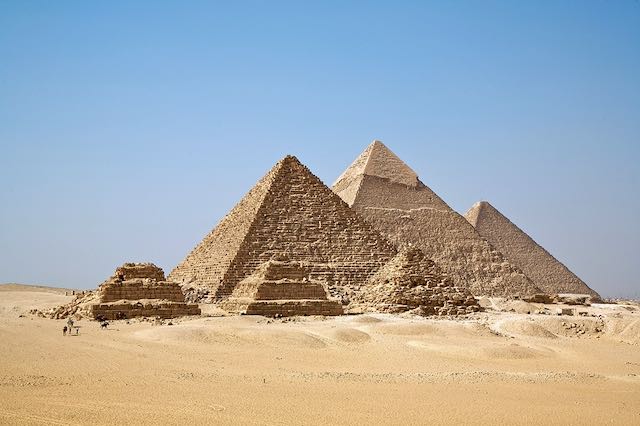
Pyramids were built as tombs for ancient Egyptian pharaohs, serving as a place to house their mummified bodies and treasures, with the belief that they would need these items to live comfortably in the afterlife; essentially, they were constructed to ensure the pharaoh’s eternal life and were considered a monument to their power and status. There are at least 118 known pyramids in Egypt, though many are smaller private pyramids. The most famous of these pyramids, of course are the Great Pyramid of Giza which will be our second stop on today’s journey.
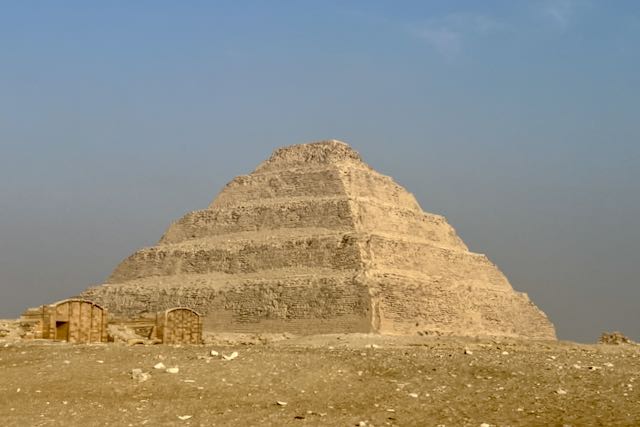
The pyramid of Djoser, sometimes called the Step Pyramid of Djoser was the first Egyptian pyramid to be built and is a 6-tier, 4-sided structure and was the earliest colossal stone building in Egypt. It was built in the 27th century BCE during the Third Dynasty for the burial of Pharaoh Djoser.
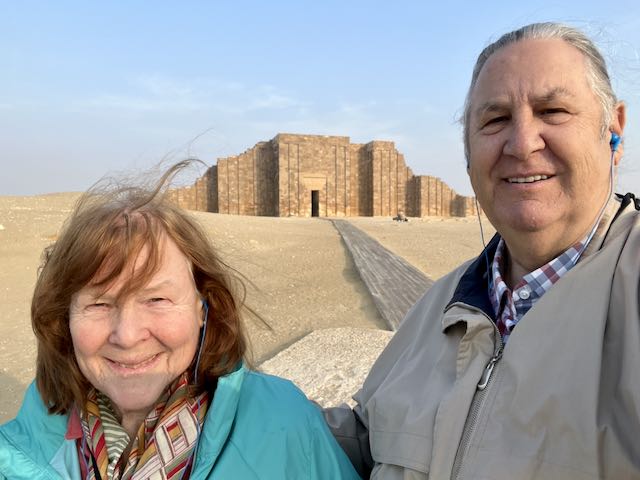
Originally there was a wall surrounding Djoser’s Step Pyramid complex and it was some 10.5 meters (34 feet) high with recessed panels decorate the entirety of its wall. The Step Pyramid Complex was thus thought of as more than a tomb, it was Djoser’s royal residence for eternity.
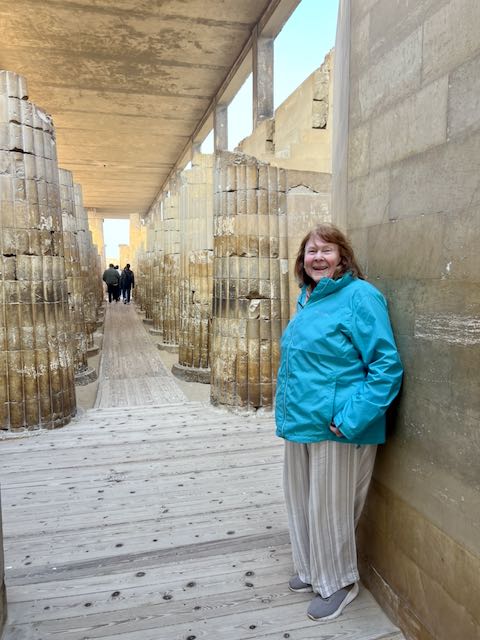
We entered Step Pyramid Complex via a colonnade entrance near its south eastern corner. This long hall is flanked by stone columns in the shape of bundles of papyrus or palm branches. These are engaged columns: instead of being free standing, each column is supported by a wall that is connected with the wall of the colonnade. At either end of the colonnade entrance is a nonfunctional imitation door that is made of stone. Their immovable leaves are built to be open, forever inviting visitors to enter and admire the king’s eternal palace. After passing through the colonnade, we approached the actual pyramid.
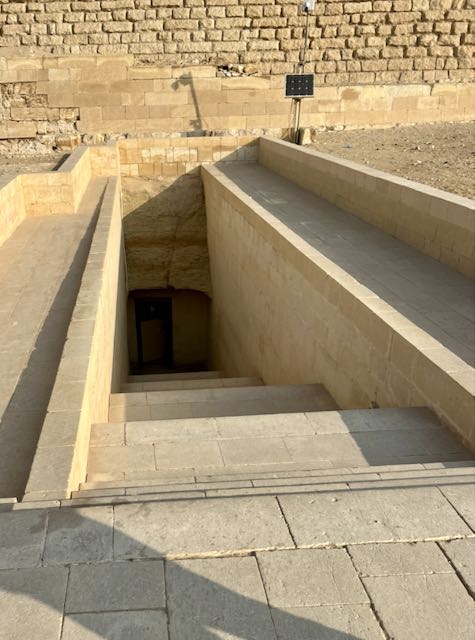
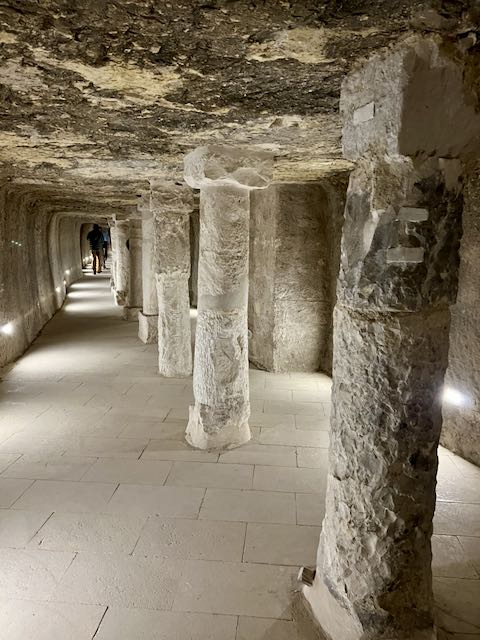
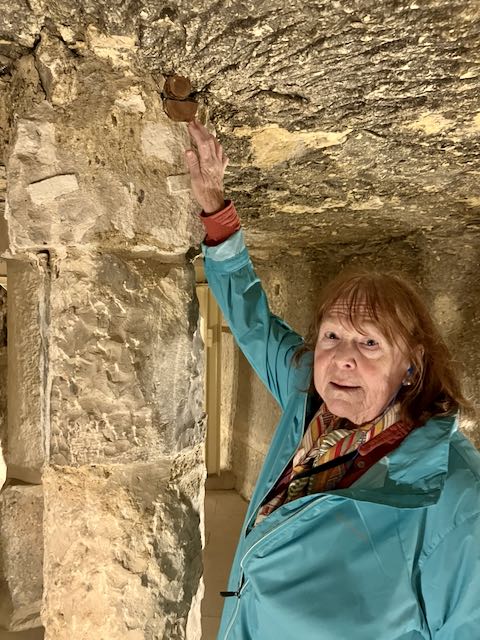
The stairs down into the Step Pyramid
The pathway to the tomb was without adornment
Janeen pointing out some wood that was used during the original construction.
The pyramid went though some restoration which was completed in 2019. This included filling in some gaps on the exterior with blocks similar to the originals. We entered through the south opening that accesses the tomb. There was not a lot of decoration but we went to where you can see down into the actual tomb. Once we finished our tour of the Step Pyramid we got back on the couch and head to The Pyramids of Giza.
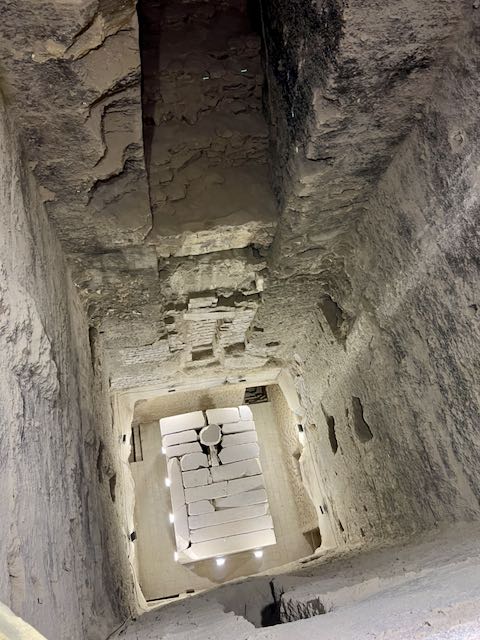
It is clear that a whole lot of words have been used to describe the Pyramids of Giza, some of which I have clearly used to help paint a picture of what we saw on our visit. The city has clearly grown towards the pyramids over time as evident by the industry, fast food and other structures you see on the way.
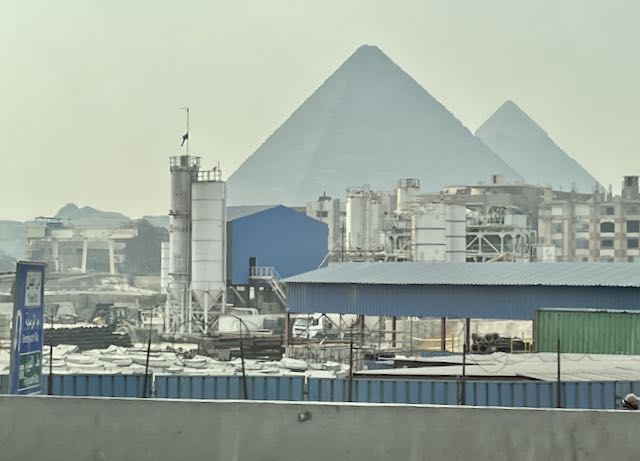
First, there are 3 pyramids – each designated by the corresponding kings for whom they were built — Khufu, Khafre, and Menkaure.
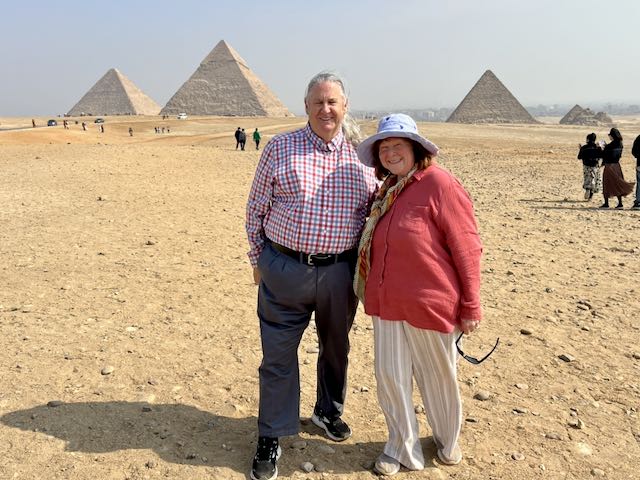
The northernmost, and oldest pyramid of the group, was built for Khufu, the second king of the 4th dynasty. Called the Great Pyramid, it is the largest of the three, its length on each side at the base averaging 755.75 feet (230 meters) and its original height would have been 481.4 feet (147 meters). The middle pyramid, which actually looks the biggest, was built for Khafre, the fourth of the eight kings of the 4th dynasty; the structure measures 707.75 feet (216 meters) on each side and was originally 471 feet (143 meters) high. The placement of the pyramid was on a higher level of the area thus making it ‘appear’ to be taller. The southernmost, and last pyramid to be built, was that of Menkaure, the fifth king of the 4th dynasty; each side measures 356.5 feet (109 meters), and the structure’s completed height was 218 feet (66 meters).
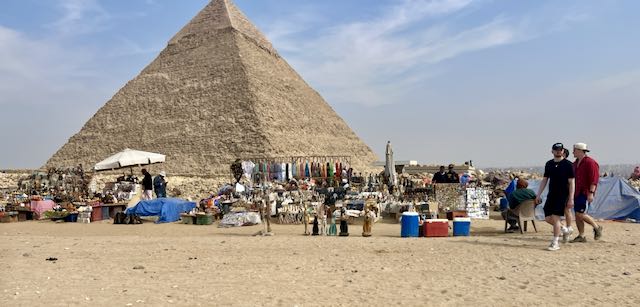
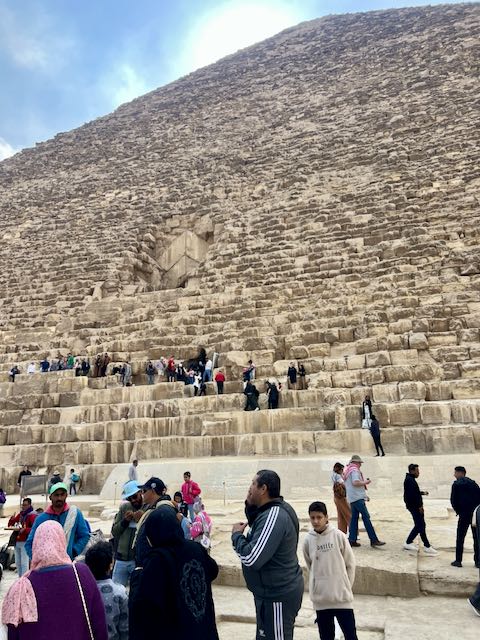
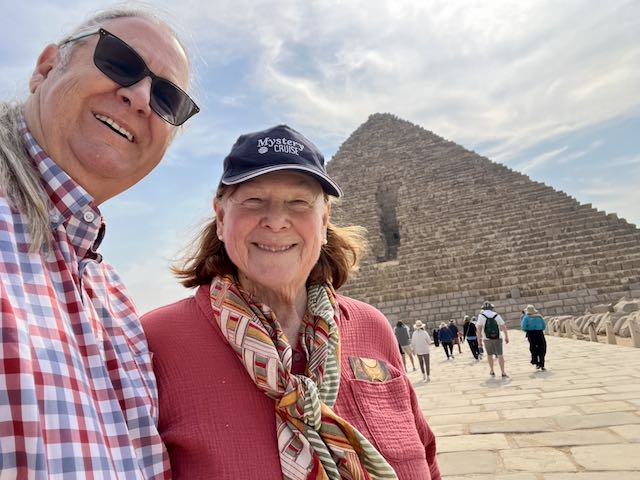
Another gauntlet of Vultures
People in line to get into the pyramid
Here we are again!
All three pyramids were plundered both internally and externally in ancient and medieval times. Thus, the grave goods originally deposited in the burial chambers are missing, and the pyramids no longer reach their original heights because they have been almost entirely stripped of their outer casings of smooth white limestone. A portion of the limestone casing still remains at the top of Khafre pyramid giving some idea of how it might have looked when it was completed.

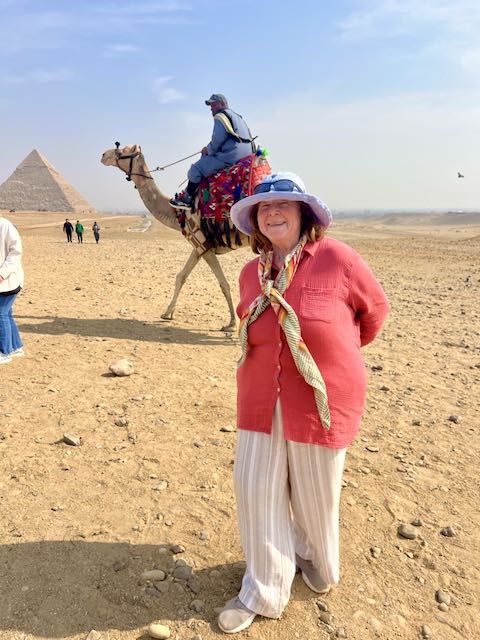
It was a lovely day to visit.
We choose NOT to take a camel ride.
Khufu’s pyramid is perhaps the most colossal single building ever erected on the planet. Its sides rise at an angle of 51° and the sides are accurately oriented to the four cardinal points of the compass. Approximately 2.3 million blocks of stone were cut, transported, and assembled to create the 5.75-million-ton structure, which is a masterpiece of technical skill and engineering ability. How the pyramids were built is still very much up for debate. The most plausible one is that the Egyptians employed a sloping and encircling embankment of brick, earth, and sand, which was increased in height and in length as the pyramid rose; stone blocks were hauled up the ramp by means of sledges, rollers, and levers.
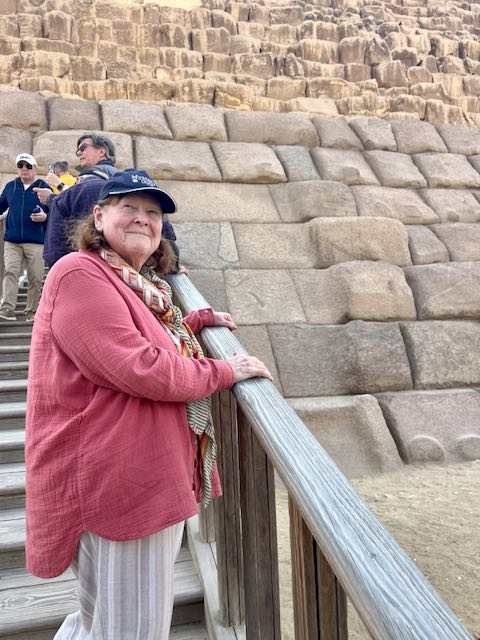
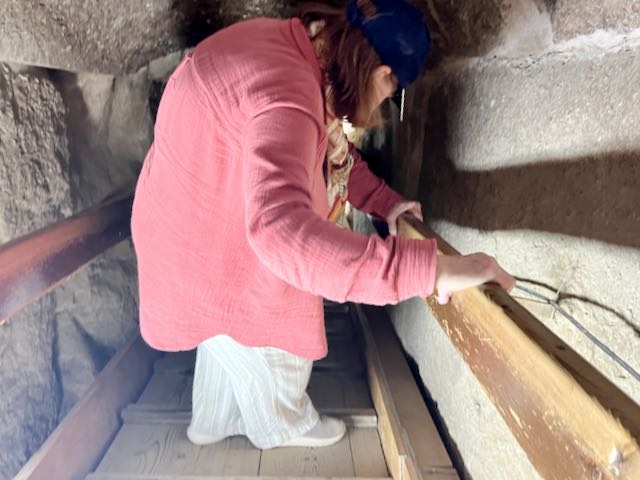
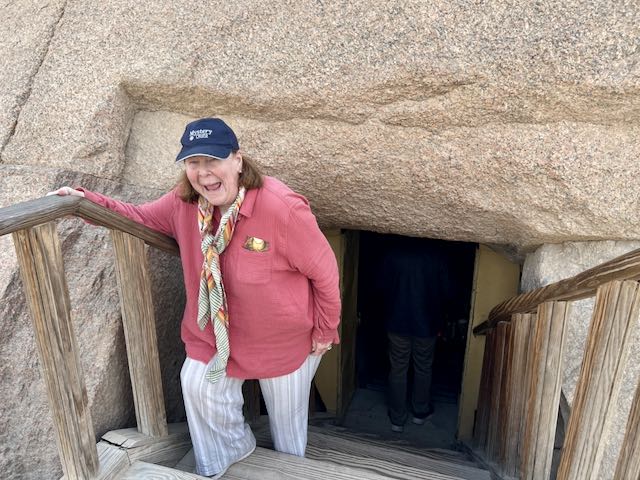
Janeen going into the pyramid. Note the smooth wall of stone. The entire pyramid would have been dressed with this but the King died before it was completed.
Not only was the ceiling low, there really wasn’t anything to see at the end of the trip!
Janeen made it back to the sunshine
To the south of the Great Pyramid near Khafre’s valley temple lies the Great Sphinx. Carved out of limestone, the Sphinx has the facial features of a man but the body of a recumbent lion; it is approximately 240 feet (73 meters) long and 66 feet (20 meters) high. This was made during the reign of King Khafre (4th king of 4th dynasty, c. 2575–c. 2465 BCE).
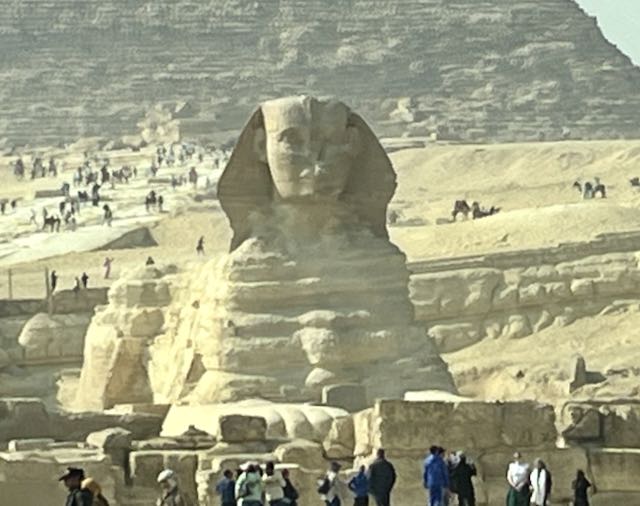
The Great Sphinx is among the world’s largest sculptures, measuring some 240 feet (73 meters) long and 66 feet (20 meters) high. It features a lion’s body and a human head adorned with a royal headdress. The statue was carved from a single piece of limestone, and pigment residue suggests that the entire Great Sphinx was painted. According to some estimates, it would have taken about three years for 100 workers, using stone hammers and copper chisels, to finish the statue.
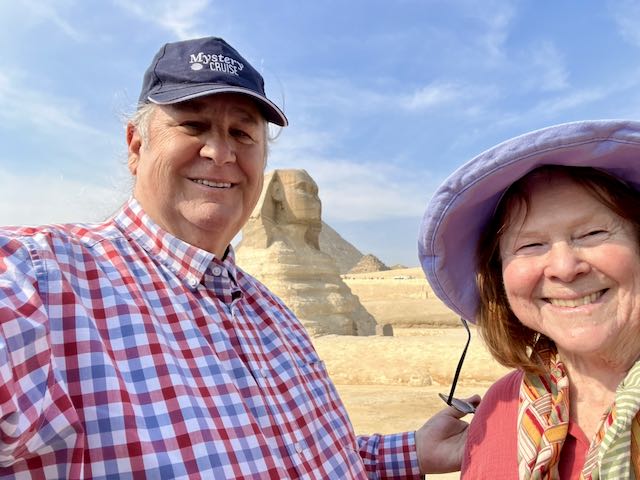
Our Egyptologist noted that the Sphinx (or “Stinks” as our granddaughter calls it) was carved from a hill which obscured the view of the pyramid, therefore requiring artisans to come up with an appropriate guardian in the view. It was so popular that subsequent pharaohs built their own crouching lions; like the one at the temple of Hatshepsut which we visited several days ago.
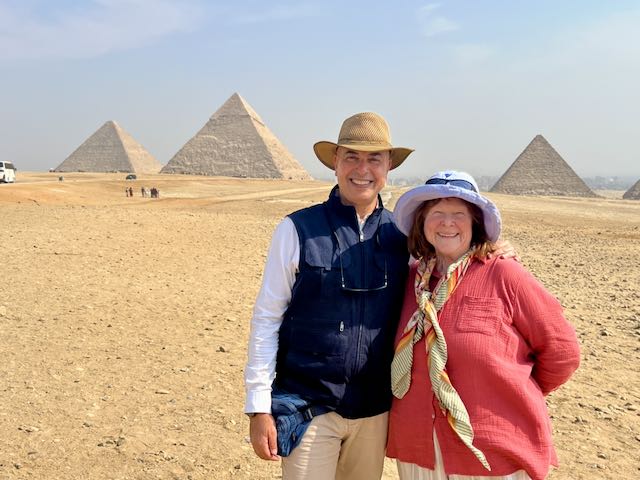
Assem, our Egyptologist, was amazing and we loved all the information he shared and the places he took us to. As this was clearly a bucket list item, it could not have been cleared any better then with our amazing trip with UniWorld.
All in all, a visit to Egypt should include coming to the Great Pyramid complex. Our visit was no exception and it was a lovely day with fantastic views. This was to be our last day for this adventure, our flight back to Germany was scheduled for 1:30 AM the next morning so we arrived at the airport several hours early and tried to continue to absorb all that we had seen and learned over the last 10 or so days.
Once back to Germany, where we are staying with our son and his family, we were able to get caught up with all our chores, do some laundry and get ready for the final month of this Grand Adventure. Stay tuned for more travel as we still have to get back to Williamsburg and that too will be a different adventure.
Another fabulous and interesting blog and I appreciate it. You will indeed have a lot to chat about upon your return to your family and the states.
I can’t believe you passed up an opportunity to experience the terror of being hurled forward over the head of a camel as it stood up. Well, maybe on your next trip to Egypt 🙂 🙂 🙂 Enjoy your visit with family and communing with the washing machine.
You really missed an experience by not riding a camel! They really smell bad and spit if insulted! It was a good experience despite those issues! I visited Cairo many years ago and think back on the experience. I loved seeing them again in your blog. Thanks for including me!
Did you see the Pizza Hut that the Sphinx looks directly at? It’s a bizarre sight for sure!
I also opted not to ride a camel. I’m not keen on riding on animals.
Yes, both Pizza Hut and KFC – what great exports the USA has…